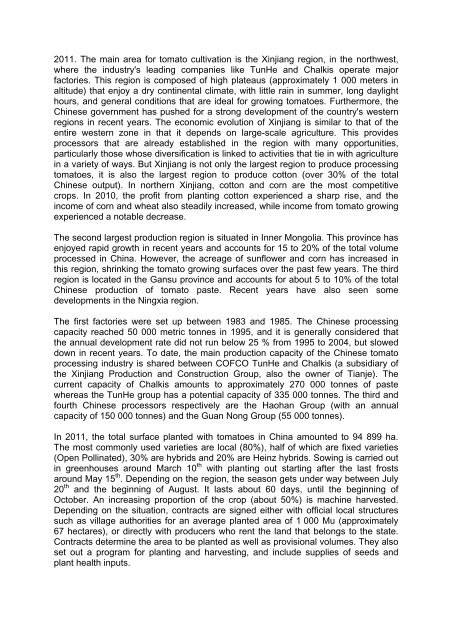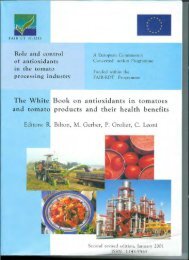Tomato processing in China
Tomato processing in China
Tomato processing in China
Create successful ePaper yourself
Turn your PDF publications into a flip-book with our unique Google optimized e-Paper software.
2011. The ma<strong>in</strong> area for tomato cultivation is the X<strong>in</strong>jiang region, <strong>in</strong> the northwest,<br />
where the <strong>in</strong>dustry's lead<strong>in</strong>g companies like TunHe and Chalkis operate major<br />
factories. This region is composed of high plateaus (approximately 1 000 meters <strong>in</strong><br />
altitude) that enjoy a dry cont<strong>in</strong>ental climate, with little ra<strong>in</strong> <strong>in</strong> summer, long daylight<br />
hours, and general conditions that are ideal for grow<strong>in</strong>g tomatoes. Furthermore, the<br />
Ch<strong>in</strong>ese government has pushed for a strong development of the country's western<br />
regions <strong>in</strong> recent years. The economic evolution of X<strong>in</strong>jiang is similar to that of the<br />
entire western zone <strong>in</strong> that it depends on large-scale agriculture. This provides<br />
processors that are already established <strong>in</strong> the region with many opportunities,<br />
particularly those whose diversification is l<strong>in</strong>ked to activities that tie <strong>in</strong> with agriculture<br />
<strong>in</strong> a variety of ways. But X<strong>in</strong>jiang is not only the largest region to produce <strong>process<strong>in</strong>g</strong><br />
tomatoes, it is also the largest region to produce cotton (over 30% of the total<br />
Ch<strong>in</strong>ese output). In northern X<strong>in</strong>jiang, cotton and corn are the most competitive<br />
crops. In 2010, the profit from plant<strong>in</strong>g cotton experienced a sharp rise, and the<br />
<strong>in</strong>come of corn and wheat also steadily <strong>in</strong>creased, while <strong>in</strong>come from tomato grow<strong>in</strong>g<br />
experienced a notable decrease.<br />
The second largest production region is situated <strong>in</strong> Inner Mongolia. This prov<strong>in</strong>ce has<br />
enjoyed rapid growth <strong>in</strong> recent years and accounts for 15 to 20% of the total volume<br />
processed <strong>in</strong> Ch<strong>in</strong>a. However, the acreage of sunflower and corn has <strong>in</strong>creased <strong>in</strong><br />
this region, shr<strong>in</strong>k<strong>in</strong>g the tomato grow<strong>in</strong>g surfaces over the past few years. The third<br />
region is located <strong>in</strong> the Gansu prov<strong>in</strong>ce and accounts for about 5 to 10% of the total<br />
Ch<strong>in</strong>ese production of tomato paste. Recent years have also seen some<br />
developments <strong>in</strong> the N<strong>in</strong>gxia region.<br />
The first factories were set up between 1983 and 1985. The Ch<strong>in</strong>ese <strong>process<strong>in</strong>g</strong><br />
capacity reached 50 000 metric tonnes <strong>in</strong> 1995, and it is generally considered that<br />
the annual development rate did not run below 25 % from 1995 to 2004, but slowed<br />
down <strong>in</strong> recent years. To date, the ma<strong>in</strong> production capacity of the Ch<strong>in</strong>ese tomato<br />
<strong>process<strong>in</strong>g</strong> <strong>in</strong>dustry is shared between COFCO TunHe and Chalkis (a subsidiary of<br />
the X<strong>in</strong>jiang Production and Construction Group, also the owner of Tianje). The<br />
current capacity of Chalkis amounts to approximately 270 000 tonnes of paste<br />
whereas the TunHe group has a potential capacity of 335 000 tonnes. The third and<br />
fourth Ch<strong>in</strong>ese processors respectively are the Haohan Group (with an annual<br />
capacity of 150 000 tonnes) and the Guan Nong Group (55 000 tonnes).<br />
In 2011, the total surface planted with tomatoes <strong>in</strong> Ch<strong>in</strong>a amounted to 94 899 ha.<br />
The most commonly used varieties are local (80%), half of which are fixed varieties<br />
(Open Poll<strong>in</strong>ated), 30% are hybrids and 20% are He<strong>in</strong>z hybrids. Sow<strong>in</strong>g is carried out<br />
<strong>in</strong> greenhouses around March 10 th with plant<strong>in</strong>g out start<strong>in</strong>g after the last frosts<br />
around May 15 th . Depend<strong>in</strong>g on the region, the season gets under way between July<br />
20 th and the beg<strong>in</strong>n<strong>in</strong>g of August. It lasts about 60 days, until the beg<strong>in</strong>n<strong>in</strong>g of<br />
October. An <strong>in</strong>creas<strong>in</strong>g proportion of the crop (about 50%) is mach<strong>in</strong>e harvested.<br />
Depend<strong>in</strong>g on the situation, contracts are signed either with official local structures<br />
such as village authorities for an average planted area of 1 000 Mu (approximately<br />
67 hectares), or directly with producers who rent the land that belongs to the state.<br />
Contracts determ<strong>in</strong>e the area to be planted as well as provisional volumes. They also<br />
set out a program for plant<strong>in</strong>g and harvest<strong>in</strong>g, and <strong>in</strong>clude supplies of seeds and<br />
plant health <strong>in</strong>puts.









